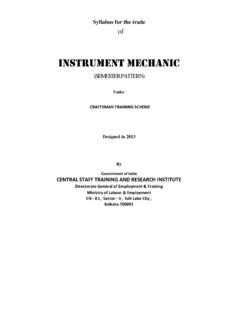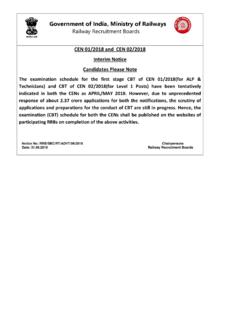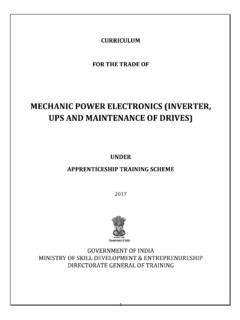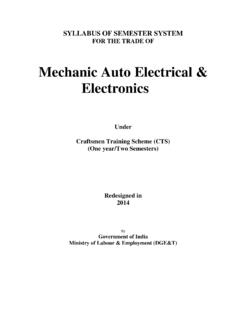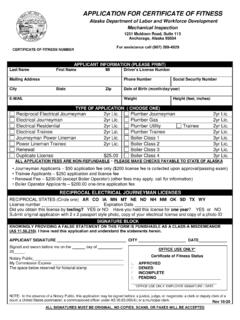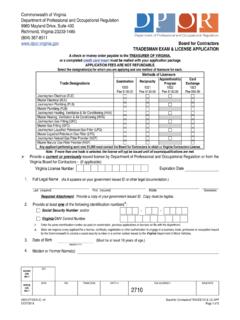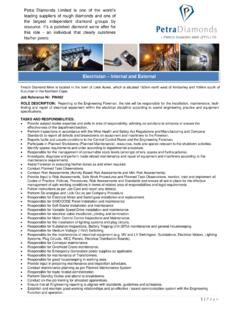Transcription of ELECTRICIAN
1 1 COMPETENCY BASED CURRICULUM FOR THE trade OF ELECTRICIAN UNDER CRAFTSMAN TRAINING SCHEME (CTS) IN SEMESTER PATTERN BY GOVERNMENT OF INDIA MINISTRY OF SKILL DEVELOPMENT & ENTREPRENEURSHIP DIRECTORATE GENERAL OF TRAINING 2 CONTENTS Sl. No. Topics Page No. 1. Introduction 3-4 2. Job roles: reference NOS & NCO 5 - 6 3. NSQF compliance block 7 4. Learning outcome 8-9 5. General information 10 6. Course structure 11 7. General Training Plan, Examination & Pass Regulation 12 8. Assessable outcome 13 9. Assessment criteria 14-22 10. Syllabus content with time structure Syllabus content for Professional Skill & Knowledge Syllabus content of core skills 23 37 38 - 46 11. Employability skills General information Distribution of topics between semesters for employability skill Syllabus content of Employability Skill 47 48 49- 53 12.
2 Infrastructure 54 13. Assessment standard guideline Internal assessments (Formative assessment) Final assessment- All India trade Test(Summative assessment) 55-59 14. List of trade committee members 60-61 15. List of Tools & Equipment-Annexure-I 62-67 16. Guidelines for instructors and paper setters- Annexure-II 68 3 1. INTRODUCTION India is one of the youngest nations in the world. Our youth are our strength. However, a challenge facing the country is that of skilling our youth as per the demands of the industry. Recognizing the need for quickly coordinating the skill development and entrepreneurship efforts of all concerned stakeholders, the Government of India created the Ministry of Skill Development and Entrepreneurship on 9th November, 2014. To create further convergence between the Vocational Training System through Industrial Training Institutes (ITIs) and the new skill initiatives of the Government, the Training and Apprenticeship Training divisions from the Directorate General of Employment and Training (DGET) under the Ministry of Labour and Employment stand transferred to the Ministry of Skill Development and Entrepreneurship (MSDE) with effect from 16th April, 2015.
3 This move brings over 11000 ITIs and scores of other institutions, and the Apprenticeship and Training divisions, under the Ministry. The Ministry of Skill Development and Entrepreneurship is an apex organization for the development and coordination of the vocational training including Women s Vocational Training in our country. The Ministry conducts the vocational training programmes through the Craftsmen Training Scheme (CTS), Apprenticeship Training Scheme (ATS), Modular Employable Scheme (MES) under the Skill Development Initiative (SDI) Scheme, and Craftsmen Instructor Training Scheme (CITS) to cater the needs of different segments of the Labour market. The National Council for Vocational Training (NCVT) acts as a central agency to advise Government of India in framing the training policy and coordinating vocational training throughout India.
4 The day-to-day administration of the ITIs rests with the State Governments/ Union Territories. Training courses under the CTS is being offered through a network of more than 11000 Government and Private Industrial Training Institutes (ITIs) located all over the country with a total seating capacity of more than 16 Lakhs with an objective to provide skilled workforce to the industry in 126 trades. Skill development courses exclusively for women are also being offered under CTS and other schemes through Government and Private ITIs and Regional Vocational Training Institutes (RVTIs) for Women. The Apprentices Act, 1961 was enacted with the objective of regulating the program of apprenticeship training in the industry by utilizing the facilities available within for imparting on-the-job training.
5 The Act makes it obligatory for employers in specified industries to engage apprentices in designated trades to impart on the job training for school leavers, and ITI passed outs to develop skilled manpower for the industry. The Ministry is implementing the Employable Scheme (MES) under the Skill Development Initiative Scheme to provide vocational training to people to develop skilled manpower for the industry through a network of Vocational Training Providers (VTPs) located across the country. Central Staff Training and Research Institute (CSTARI), Kolkata is the nodal institute for the development/revision of curricula under all vocational training schemes of the Ministry. 4 National Instructional Media Institute (NIMI), Chennai is to make available instructional material in various trades for the use of trainees and trainers to ensure overall improvement in the standard of institutional training under the CTS and ATS schemes.
6 The institute is actively involved in the development, production and dissemination of instructional media Packages (IMPs) comprising of books on trade Theory, trade Practical, Test/Assignment, and Instructor s Guide. The National Skills Qualification Framework (NSQF), published in the Gazette of India on 27th December, 2013, is a national framework that aims to integrate general and vocational streams of education and training. The main goal of the NSQF is to focus on competency-based qualifications, which in turn facilitate and enhance transparency, both within and between general and vocational streams. The National Skill Development Agency (NSDA) under the Ministry is responsible for anchoring and implementation of the Framework, by bringing together the key stakeholders through the National Skill Qualifications Committee (NSQC).
7 The competency-based framework organizes qualifications into ten levels, with the entry level being 1, and the highest level being 10. Each level of the NSQF is described by a statement of learning outcomes in five domains, known as level descriptors. These five domains are (1) Process, (2) Professional knowledge, (3) Professional skill, (4) core skill, and (5) Responsibility. The paradigm shift from learning focused on inputs to an outcome/competency-based education would help in the Recognition of Prior Learning (RPL), and simultaneously enable the alignment of the Indian qualifications with international ones. Government funding is expected to be on a preferential basis for NSQF compliant courses. The NSQF notification provides a Qualification Register, which is the official national database of all qualifications aligned to NSQF levels.
8 Through this Register, learners can expect access to all NSQF compliant qualifications. The Ministry has set up Mentor Councils to focus on courses under NCVT in various sectors with representation from thought leaders among different stakeholders viz., industries, innovative entrepreneurs who have proved to be game-changers, academic/professional institutions, and champion ITIs for each of the sectors. The Mentor Council for each sector reviews curriculum, admission criteria, course duration, and requirement of trainers and assessment/evaluation systems for the sector on a continuous basis and make recommendations regarding the same. Sector-wise Core Groups are formed to plan and prepare the documentation for the competency-based curricula for the courses under each sector.
9 5 1. JOB ROLES: Reference NOS & NCO Brief description of Job roles: ELECTRICIAN , General installs, maintains and repairs electrical machinery equipment and fittings in factories, workshops power house, business and residential premises etc., Studies drawings and other specifications to determine electrical circuit, installation details, etc. Positions and installs electrical motors, transformers, switchgears. Switchboards, Microphones, loud-speakers and other electrical equipment, fittings and lighting fixtures. Makes connections and solders terminals. Test electrical installations and equipment and locates faults using megger, test lamps etc. Repairs or replaces defective wiring, burnt out fuses and defective parts and keeps fittings and fixtures in working order.
10 May do armature winding, draw wires and cables and do simple cable jointing. May operate, attend and maintain electrical motors, pumps etc. Electrical Electricianfits and assembles electrical machinery and equipment such as motors, transformers, generators, switchgears, fans etc., Studies drawings and wiring diagrams of fittings, wiring and assemblies to be made. Collects prefabricated electrical and mechanical components according to drawing and wiring diagrams and Check them with gauges, meggeretc, to ensure proper function and accuracy. Fits mechanical components, resistance, insulators, etc., as per specifications, doing supplementary tooling where necessary. Follows wiring diagrams, makes electrical connections and solders points as specified. Check for continuity, resistance, circuit shorting, leakage, earthing, etc, at each stage of assembly using megger, ammeter, voltmeter and other appliances and ensures stipulated performance of both mechanical and electrical components filled in assembly.
